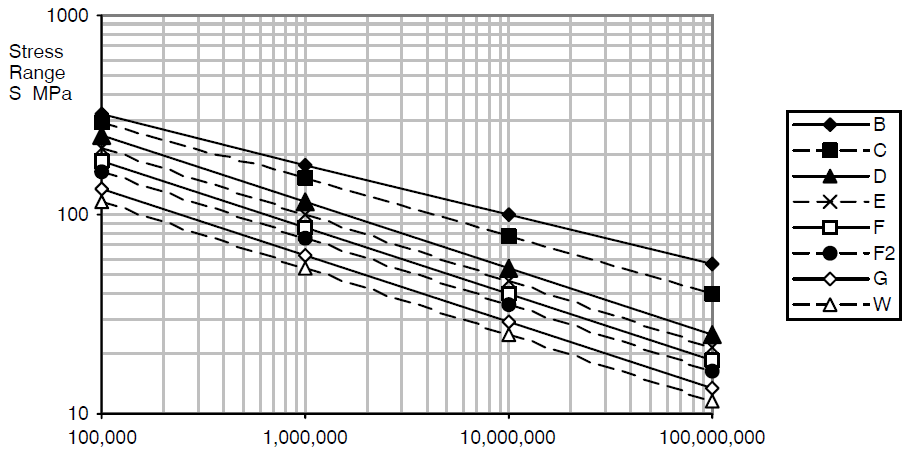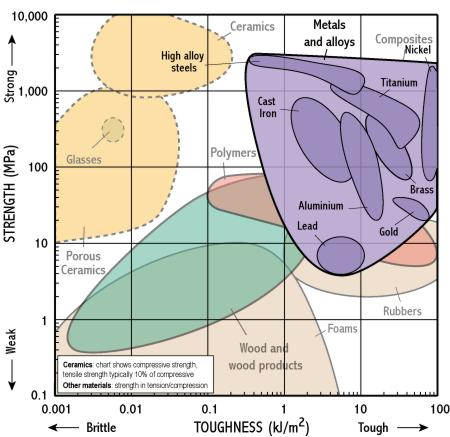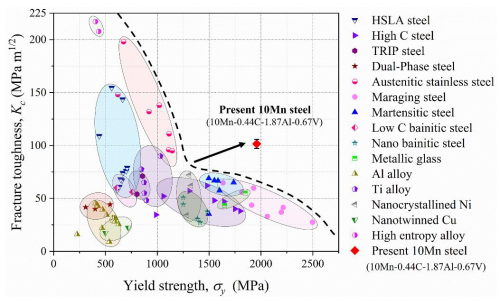mollwollfumble said:
The Rev Dodgson said:
mollwollfumble said:
I could add fatigue resistance to that, but for steels other than stainless the fatigue resistance is half the strength.
Can you let the people as Standards Australia know that?
It will save me a lot of time, and save my clients a lot of steel.
Really?
Your clients need to know the fatigue resistance of steel?
Column 6 in the table on Engineering toolbox. https://www.engineeringtoolbox.com/steel-endurance-limit-d_1781.html
I noted a while back that steel technology, despite its antiquity, has kept advancing to the point where steel alloy is still the strongest of all known metals.
From: https://www.google.com/url?sa=t&rct=j&q=&esrc=s&source=web&cd=&ved=2ahUKEwiBsv_k-pbrAhUXxzgGHSruAOcQFjAKegQIBRAB&url=https%3A%2F%2Fwww.skyshop.com.au%2FMETALS.pdf&usg=AOvVaw3hIb6r-3VmMJGCZt-WbyGo
Steel, some common types. It looks as if weldability and case hardening are other very important considerations.
1010 This is one of the most widely used low carbon steels for low strength applications. It is best suited for parts whose fabrication involves moderate to severe forming and some machining. Its weldability is excellent and it can be case hardened for wear resistance by cyaniding.
1018 is a popular carburizing grade of steel. It can be strengthened by cold working or surface hardened by carburizing or cyaniding. It is relatively soft and has good weldability and formability.
1020 is a general-purpose low-carbon “mild” steel. It is easy to fabricate by the usual methods such as mild cold or hot forming and welding. It is weldable by all processes and the resulting welds are of extremely high quality.
4130 This chromium-molybdenum alloy is one of the most widely used aircraft steels because of its combination of weldability, ease of fabrication and mild hardenability. In relatively thin sections, it may be heat treated to high strength levels. In the normalized condition it has adequate strength for many applications. It may be nitrided for resistance to wear and abrasion.
4140 This chromium-molybdenum alloy is a deep hardening steel used where strength and impact toughness are required. It has high fatigue strength making it suitable for critical stressed applications. It may be nitrided for increased resistance to wear and abrasion.
4340 This chromium-nickel-molybdenum alloy is a widely used deep hardening steel. It possesses remarkable ductility and toughness. With its high alloy con tent uniform hardness is developed by heat treatment in relatively heavy sections. Its high fatigue strength makes it ideal for highly stressed parts.
6150 This chromium-vanadium alloy steel is similar to 4340. It has good hardenability, good fatigue properties and excellent resistance to impact and abrasion.
8620 This is a “triple alloy” chromium-nickel-molybdenum steel. It is readily carburized. It may be heat treated to produce a strong, tough core and high case hardness. It has excellent machinability and responds well to polishing operations. It is easily welded by any of the common welding processes, although the section should be heated and stress relieved after welding.
9310 This chromium-nickel-molybdenum alloy is a carburizing steel capable of attaining high case hardness with high core strength. It has excellent toughness and ductility.
4620 This nickel-molybdenum alloy is a carburizing steel capable of developing high case hardness and core toughness. It can be forged similarly to the other carburizing grades. Because of its relatively high nickel content, it is not as readily cold-formed.
5160 This carbon-chromium grade of spring steel has a high yield/tensile strength ratio, excellent toughness and high ductility. It is very difficult to machine in the as-rolled condition and should be annealed prior to machining. It is not readily welded, but it can be welded by either the gas or arc welding processes if the section involved is preheated and stress relieved after welding.
52100 This high carbon-high chromium alloy is produced by the electric furnace process and then vacuum degassed to meet the rigid standards of the aircraft industry for bearing applications. It develops high hardness and has exceptional resistance to wear and abrasion.
EFFECTS OF COMMON ALLOYING ELEMENTS IN STEEL
By definition, steel is a combination of iron and carbon. Steel is alloyed with various elements to improve physical properties and to produce special properties, such as resistance to corrosion or heat. Specific effects of the addition of such elements are outlined below:
CARBON ©, although not usually considered as an alloying element, is the most important constituent of steel. It raises tensile strength, hardness and resistance to wear and abrasion. It lowers ductility, toughness and machinability.
MANGANESE (Mn) is a deoxidizer and degasifier and reacts with sulphur to improve forgeability. It in creases tensile strength, hardness, hardenability and resistance to wear. It decreases tendency toward scaling and distortion. It in creases the rate of carbon-penetration in carburizing.
PHOSPHORUS (P) increases strength and hardness and improves machinability. However, it adds marked brittleness or cold-shortness to steel.
SULPHUR (S) Improves machinability in free-cutting steels, but without sufficient manganese it produces brittleness at red heat. It decreases weldability, impact toughness and ductility.
SILICON (Si) is a deoxidizer and degasifier. It increases tensile and yield strength, hardness, forgeability and magnetic permeability.
CHROMIUM (Cr) increases tensile strength, hardness, hardenability. toughness, resistance to wear and abrasion. resistance to corrosion and scaling at elevated temperatures.
NICKEL (Ni) increases strength and hardness without sacrificing ductility and toughness. It also increases resistance to corrosion and scaling at elevated temperatures when introduced in suitable quantities in high chromium (stainless) steels.
MOLYBDENUM (Mo) increases strength, hardness, hardenability and toughness, as well as creep resistance and strength at elevated temperatures. It improves machinability and resistance to corrosion and it intensifies the effects of other alloying elements. In hot-work steels, it increases red-hardness properties.
TUNGSTEN (W) increases strength, hardness and toughness. Tungsten steels have superior hot-working and greater cutting efficiency at elevated temperatures.
.
VANADIUM (V) increases strength, hardness and resistance to shock impact. It retards grain growth, permitting higher quenching temperatures. It also enhances the red hardness properties of high speed metal cutting tools and intensifies the individual effects of other major elements.
COBALT (Co) Increases strength and hardness and permits higher quenching temperatures. It also intensifies the individual effects of other major elements in more complex steels.
ALUMINUM (Al) is a deoxidizer and degasifier. It retards grain growth and is used to control austenitic grain size. In nitriding steels it aids in producing a uniformly hard and strong nitrided case when used in amounts 1.00% – 1.25%.
LEAD (Pb), while not strictly an alloying element, is added to improve machining characteristics. It is almost completely in soluble in steel, and minute lead particles, well dispersed, reduce friction where the cutting edge contacts the work. Addition of lead also improves chip-breaking formations.
(OK, so far so good. I’m still not where I want to be. I want to see a plot of toughness vs strength for all common steel grades, and relationships between these and other properties such as machinability).





